A Content Analysis of AIAA/ITEA/ITEEA Conference Special Interest Sessions: 1978-2014
Associations routinely hold annual conferences to aid with professional development and actively promote the ideals of their membership and the profession they represent. The American Industrial Arts Association (AIAA) was created in 1939 and has held an annual conference the past 76 years to further these goals ( Starkweather, 1995 ). Throughout this period, the profession has gone through significant changes that include a paradigm shift from a focus on the products and processes of industry to a broader focus on technological literacy. The AIAA reflected this shift by changing the association name to the International Technology Education Association (ITEA) in 1985. More recently, the association adapted to the increasing focus on engineering education and changed its name again in 2010 to the International Technology and Engineering Educators Association (ITEEA). The ITEEA conference has run consistently throughout this period and remains a cornerstone professional event. Analysis of the detailed conference programs can highlight historical milestones, current status, and emerging trends within the profession to aid with conference planning and other professional activities.
Purpose and Approach
This content analysis was designed to highlight, among other topics, conference history, trends and issues, leadership, scholarly research, curriculum, and instructional methods. According to Silverman (1993) , classic content analysis emphasizes a systematic, objective, quantitative description of content derived from researcher-developed categories. Contemporary forms, however, include both numeric and interpretive means of analyzing data ( Julien, 2008 ). This study utilized both approaches. Initially, 22 conferences (1978-1999) were analyzed using a deductive process that produced frequency counts from categories predetermined by the researchers ( LaPorte & Reed, 2000 ). The initial work was built upon by adding 15 conference programs (2000-2014), searching the initial categories, and using an inductive approach to produce frequency counts for additional categories derived from a careful reading of the programs.
Methods
This study focused only on the special interest sessions ( N = 5,639) for the 1978-2014 ITEEA conferences. It did not include pre- and post-conference workshops, general sessions, meetings, meal functions, exhibits, or other activities. The study is limited to special interest sessions because they are standard in length, are vetted by the conference planning committee, make up the bulk of the conference program, and are of varying topics that formulate the basis for trend line analysis. Additionally, other conference activities often have a defined focus that does not provide such trends. These 37 years were a convenience sample since the researchers had the conference programs on hand, and the researchers also felt that the sample was broad enough to highlight the paradigm shift from industrial arts to technology education and the increased focus on engineering, among other trends. An official archive of ITEEA materials is maintained at Millersville University of Pennsylvania.
Initially, paper copies of conference programs were scanned with optical character recognition (OCR) software, and the resulting text files were edited with Microsoft Word and imported into Microsoft Access to form a searchable database. Electronic conference programs in portable document format (PDF) were obtained from the ITEEA starting in 2000, and these files were converted into Microsoft Word documents, cleaned, and imported into the Microsoft Access database. The database was designed with five fields for each interest session: year, sponsor, title, description, and presenters. The sponsor field describes the type of interest session (e.g., ITEEA, CTETE). Table 1 lists the session sponsors and includes name changes, acronyms, the number of sponsored sessions, and inclusive years of support.
Figure 1 illustrates the four major categories that were initially established for the 31 searchable topics during the deductive inquiry: new content organizers, old content organizers, individual topics, and topics concerning diversity. The seven old content organizers were based on historical course offerings in industrial arts or technology education. New organizers were based primarily on the Jackson's Mill Industrial Arts Curriculum Theory ( Snyder & Hales, 1981 ) but also included an option for interest sessions that focused on production. More contemporary curriculum offerings based on the Standards for Technological Literacy ( International Technology Education Association [ITEA], 2000 ) were later searched using the inductive approach described above.
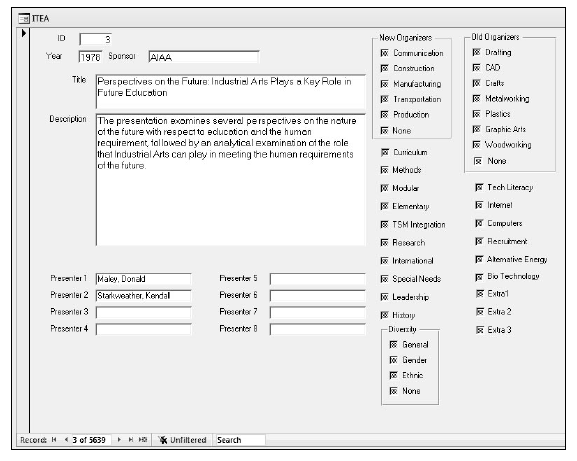
Figure 1.
Fields, categories, and topics for each entry in the 1978-2014 ITEEA conference special interest session database.
The tagging for initial analysis for the years 1978-1999 was conducted by one researcher who read the session title and description to determine the primary focus. The researcher's interpretation of the presenters primary focus (as written in the description and title) can be a limitation of this method. If a session did not fit into one of the 31 topics, it was not tagged. Content interest sessions were tagged only once as one of the old content organizers or one of the new content organizers, not both. If the interest session did not fit any of the old or new content organizers, it was not marked in these classifications. In addition to content organizers, interest sessions could be tagged in 16 individual topics. Unlike the content organizers, however, interest sessions could be tagged more than once if their focus fit into several individual topics. The fourth classification section focused on diversity. Similar to the content organizers, interest sessions that focused on diversity could only be tagged in one of three topics. The three topics were gender, ethnicity, and general diversity.
Table 1
Session Sponsors
| Acronym | Name(s) |
Sponsored
Sessions a |
Inclusive
Years |
|---|---|---|---|
| ACESIA | American Council for Elementary School Industrial Arts (later TECC, currently CC) | 40 | 1978-1985 |
| ACIAS | American Council of Industrial Arts Supervisors (later CS, currently CSL) | 38 | 1978-1987 |
| ACIASAO | American Council of Industrial Arts State Association Officers | 27 | 1978-1986 |
| ACIATE | American Council on Industrial Arts Teacher Education (later CTTE, currently CTETE) | 42 | 1978-1986 |
| AIAA | American Industrial Arts Association b (later ITEA, currently ITEEA) | 898 | 1978-1985 |
| AIACSA | American Industrial Arts College Student Association (later TECA, currently TEECA) | 25 | 1978-1983 |
| AIASA | American Industrial Arts Student Association (currently TSA) | 16 | 1980-1988 |
| CATTS | Center for the Advancement of Teaching Technology and Science (currently the STEM Center for Teaching and Learning) | 22 | 2002-2007 |
| CC | Children's Council of ITEEA (formerly ACESIA and TECC) | 33 | 2011-2014 |
| Commercial c | Too many to list. | 220 | 1978-1997 |
| CS | Council of Supervisors(formerly ACIAS, currently CSL) | 66 | 1988-2010 |
| CSL | ITEEA's Council for Supervision and leadership(formerly ACIAS and CS) | 11 | 2011-2014 |
| CTEA | Council of Technology Education Associations | 12 | 1987-1992 |
| CTETE | Council on Technology and Engineering Teacher Education (formerly ACIATE and CTTE) | 29 | 2013-2014 |
| CTTE | Council on Technology Teacher Education (formerly ACIATE, currently CTETE) | 259 | 1983-2012 |
| EbD | Engineering by Design | 92 | 2008-2014 |
| EPT | Epsilon Pi Tau | 6 | 1979-2008 |
| ICTE | International Conference on Technology Education | 10 | 2007 |
| International | 73 | 1988-1992 | |
| ITEA | International Technology Education Association d (formerly AIAA, currently ITEEA) | 2,804 | 1986-2010 |
| ITEEA | International Technology and Engineering Educators Association (formerly AIAA and ITEA) | 392 | 2011-2014 |
| NAE | National Academy of Engineering | 4 | 2006-2009 |
| NASA | National Aeronautics and Space Administration | 87 | 1991-2012 |
| NSF | National Science Foundation | 15 | 2004-2008 |
| PATT | Pupils Attitudes Towards Technology | 111 | 2000-2014 |
| TECA | Technology Education Collegiate Association (formerly AIACSA, currently TEECA) | 29 | 1984-2012 |
| TECC | Technology Education for Children Council(formerly ACESIA , currently CC) | 186 | 1987-2010 |
| TSA | Technology Student Association (formerly AIASA) | 29 | 1983-2014 |
a
Total sponsored sessions listed (
n
= 5,576) do not equal total conference sessions
(
N
= 5,639) due to the numerous sponsors of 1-2 sessions that are not listed here.
b
Includes the AIAA sessions cosponsored with councils.
c
Commercial sessions are those sponsored by companies during the normal conference program and run
concurrent with other special interest sessions. This does not include pre- and post-conference workshops or sessions that
companies held on the exhibit floor.
d
Includes the ITEA sessions cosponsored with councils and the Technology Interest Group (TIG; four sessions in 2009).
A second researcher tagged the interest sessions for the years 2000-2014 using the same methodology for the original 31 topics. To aid in the reliability of tagging, the second researcher reviewed several years from the initial analysis, and one year that had been tagged by the initial researcher (1999) was blindly tagged by the second researcher and compared to the initial tags. This analysis revealed a reliability coefficient of .61, which is low but generally acceptable ( Julien, 2008 ). Additionally, database query tools were used to search 17 other topics that emerged from reviewing conference programs.
Findings
The following findings are based on the tagging and queries of the ITEEA 1978-2014 conference special interest session database. Table 2 lists the conference locations, focus or themes, and the number of special interest sessions by year. Conference locations in the east, midwest, and plains appear to be well represented with few locations in or past the Rockies and no conferences outside of the continental United States. The frequency counts for each of the 48 categories and the mean number of presentations per year, as well as significant peaks, are presented in Table 2 within three categories: curriculum organizers, diversity, and individual topics. The initial curriculum categories (old and new) were collapsed and other curriculum content organizers were added, primarily to reflect the Standards for Technological Literacy ( ITEA, 2000 ). Topics are listed alphabetically in Table 3, but many topics are combined below to highlight relevant relationships.
Curriculum Organizers
ITEEA special interest sessions that focused on curriculum packages, revision, theories, and the history of curriculum were by far the largest number of special interest sessions. These sessions may or may not have also been tagged in other fields depending on the primary focus of the session. Figure 2 illustrates the 1,533 special interest sessions that focus on curriculum. The mean of 41 sessions per year is almost one third of all conference special interest sessions per year, with the peak in 2009 ( n = 92) representing well over half of the sessions that year. This category has a steady upward trend, and sessions since 2000 focus heavily on technological literacy, STEM, and elementary curriculum.
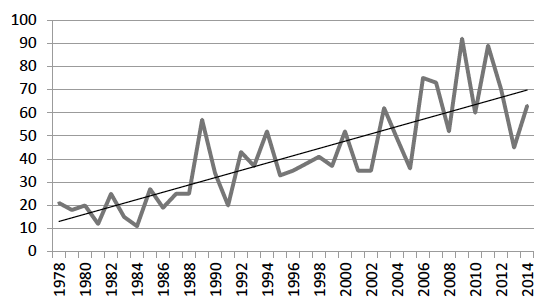
Figure 2.
Curriculum special interest sessions with trend line.
Table 2
Conferences by Year
| Year | No. | Location | Focus/Theme | Sessions |
|---|---|---|---|---|
| 1978 | 40 | Atlanta, Georgia | Industrial Arts: Youth's Gateway to the Future | 136 |
| 1979 | 41 | San Antonio, Texas | Industrial Arts-Preparation for Life in A Technological World | 176 |
| 1980 | 42 | St. Louis, Missouri | The Spirit of Progress | 164 |
| 1981 | 43 | Pittsburgh, Pennsylvania | The Golden Triangle of Industrial Arts: Industry-Culture-Environment | 164 |
| 1982 | 44 | Hartford, Connecticut | Industrial Arts: A Heritage of Technical Progress | 166 |
| 1983 | 45 | Milwaukee, Wisconsin | Interfacing Technology, Education, and the World | 154 |
| 1984 | 46 | Columbus, Ohio | Discovering, Reflecting, Interfacing Technology | 100 (low) |
| 1985 | 47 | San Diego, California | Technology Reaching Out | 184 |
| 1986 | 48 | Kansas City, Missouri | Industry/Technology Education: Commitment to Excellence | 132 |
| 1987 | 49 | Tulsa, Oklahoma | Technology Education: Teaching Tomorrow Today | 132 |
| 1988 | 50 | Norfolk, Virginia | Technosphere '88: A Technological Journey | 119 |
| 1989 | 51 | Dallas,Texas | Creating the Future: Implementing Curriculum Models | 162 |
| 1990 | 52 | Indianapolis, Indiana | Education and Technology: Racing into the Future Together | 146 |
| 1991 | 53 | Salt Lake City, Utah | Technology Education in the Space Age | 152 |
| 1992 | 54 | Minneapolis, Minnesota | Integrating Technology, People and the Environment | 155 |
| 1993 | 55 | Charlotte, N. Carolina | Technological Literacy for Life and Work | 147 |
| 1994 | 56 | Kansas City, Missouri | Technology Education: Preparing for the Global Community | 202 (high) |
| 1995 | 57 | Nashville, Tennessee | Technology Education and the Multicultural Society | 132 |
| 1996 | 58 | Phoenix, Arizona | Technology Education: Educating the Next Generation | 139 |
| 1997 | 59 | Tampa, Florida | Managing Our Evolving Mission | 129 |
| 1998 | 60 | Fort Worth, Texas | Technology Education: The Frontier of the Future | 129 |
| 1999 | 61 | Indianapolis, Indiana | Technology Education: Creating A World Class Profession | 146 |
| 2000 | 62 | Salt Lake City, Utah | Innovation & Diffusion in Technology Education | 158 |
| 2001 | 63 | Atlanta, Georgia | Teaching Technology in A Virtual World | 135 |
| 2002 | 64 | Columbus, Ohio | Positioning Technological Literacy in the Mainstream of Education | 136 |
| 2003 | 65 | Nashville, Tennessee | Advancing Information and Knowledge Through Innovation | 160 |
| 2004 | 66 | Albuquerque, New Mexico | Teaching Decision Making in A Technological World | 160 |
| 2005 | 67 | Kansas City, Missouri | Preparing the Next Generation for Technological Literacy | 125 |
| 2006 | 68 | Baltimore, Maryland | Living in a World with Smart Technology | 171 |
| 2007 | 69 | San Antonio, Texas | Technological Literacy: A Global Challenge | 193 |
| 2008 | 70 | Salt Lake City, Utah | Teaching TIDE With Pride! | 162 |
| 2009 | 71 | Louisville, Kentucky | Delivering the T & E in STEM | 195 |
| 2010 | 72 | Charlotte, N. Carolina | Green Technology: STEM Solutions for 21st Century Citizens! | 162 |
| 2011 | 73 | Minneapolis, Minnesota | Preparing the STEM Workforce | 168 |
| 2012 | 74 | Long Beach, California | Changing the Conversation: Improving P-16 Technology and Engineering | 154 |
| 2013 | 75 | Columbus, Ohio | Improving Technology and Engineering Education for All Students: A Plan of Action | 133 |
| 2014 | 76 | Orlando, Florida | Technology and Engineering: Bringing STEM to Life | 161 |
| Mean= | 152 |
Table 3
Analysis of Search Categories
| Search | Topic | Yearly | Peak | |
|---|---|---|---|---|
| Categories | Totals | Mean | Sessions | Year(s) |
| Curriculum | ||||
| Agriculture | 2 | 0.05 | * | * |
| Biotechnology | 59 | 1.60 | 5 | 2009 |
| CAD | 74 | 2.00 | 8 | 1985, 1987, 2000 |
| Communication | 184 | 5.00 | 14 | 2009 |
| Construction | 51 | 1.38 | 6 | 2010 |
| Crafts | 7 | 0.19 | * | * |
| Curriculum | 1,533 | 41.43 | 92 | 2009 |
| Drafting | 18 | 0.49 | 4 | 1980 |
| Electricity/Electronics | 80 | 2.16 | 7 | 1993 |
| Energy & Power | 120 | 3.24 | 17 | 1979 |
| Engineering | 505 | 13.65 | 56 | 2011 |
| Graphic Arts | 16 | 0.43 | 5 | 1981 |
| Manufacturing | 139 | 3.76 | 10 | 1985, 1994 |
| Medical | 12 | 0.32 | 2 | 2005, 2012 |
| Metalworking | 14 | 0.38 | 4 | 1982 |
| Plastics | 32 | 0.86 | 6 | 1981 |
| Production | 15 | 0.41 | 3 | 1979 |
| Technology & Society | 63 | 1.70 | 7 | 1983 |
| Transportation | 78 | 2.11 | 8 | 2009, 2014 |
| Woodworking | 53 | 1.43 | 7 | 1985 |
| Diversity | ||||
| Ethnic | 10 | 0.27 | 2 | 2007 |
| Gender | 84 | 2.27 | 10 | 2009 |
| General | 30 | 0.81 | 8 | 1995 |
| Individual | ||||
| Accreditation | 13 | 0.35 | 3 | 2004 |
| Alternative Energy | 83 | 2.24 | 11 | 1979, 2010 |
| Computers | 238 | 6.43 | 23 | 1985 |
| Creativity | 97 | 2.62 | 9 | 2003 |
| Design Process | 623 | 16.84 | 34 | 2010 |
| Distance Learning | 61 | 1.65 | 7 | 2001, 2002, 2006 |
| Elementary | 408 | 11.03 | 21 | 2011 |
| Facilities | 74 | 2.00 | 8 | 1989, 1994 |
| Funding | 159 | 4.30 | 11 | 1990 |
| Hands-On | 272 | 7.35 | 20 | 2009, 2011 |
| History | 68 | 1.84 | 7 | 1982 |
| International | 312 | 8.43 | 26 | 1989 |
| Internet | 64 | 1.73 | 8 | 1996 |
| Leadership | 298 | 8.05 | 26 | 2012 |
| Legislation | 34 | 0.92 | 4 | 1993 |
| Methods | 538 | 14.54 | 42 | 2002 |
| Modular | 85 | 2.30 | 11 | 1993, 1994 |
| Problem Solving | 249 | 6.73 | 23 | 1992 |
| Recruitment | 66 | 1.78 | 4 | 1981, 1995, 2008, 2011 |
| Research | 540 | 14.59 | 32 | 2008, 2009 |
| Robotics | 94 | 2.54 | 9 | 1985 |
| Special Needs | 66 | 1.78 | 12 | 1982 |
| Systems | 147 | 3.97 | 11 | 1989, 1990 |
| Technological Literacy | 313 | 8.46 | 26 | 2011 |
| TSM/STEM Integration | 402 | 10.86 | 47 | 2014 |
*These categories did not have a significant peak of interest sessions (0 or 1 per conference).
There are a number of curriculum organizers for which trend-line analysis was not practical because there were so few sessions or the number of sessions dropped off completely. Historical organizers include crafts, graphic arts, metalworking, plastics, production, and woodworking. Sessions on crafts were inconsistent within this study's timeframe and included only seven total sessions. There were a handful of single sessions between 1979 and 1988 with the last session appearing in 1999. Graphic arts had a similar trend with the majority of sessions occurring between 1979-1983, and the last session appearing in 1994. There were 14 metalworking sessions, primarily between 1980-1986, with the last one in 1994. Sessions on plastics totaled 32 with the majority between 1978 and 1988 and the final one in 1992. Production appears to never have emerged as a curriculum organizer with only 15 total sessions spread out from 1978-2011. Woodworking sessions spanned 1978-1994 with a rapid drop after the 1994 peak.
New curriculum organizers with very limited representation include agriculture and medical technologies. The prefix agri- was searched across titles and descriptions to identify agricultural sessions that focused on "the growing of plants and animals for food, fiber, fuel, chemical or other useful products" ( ITEA, 2000, p. 149 ). There was only one session in 1980 and one session in 2005 that met this definition. Clearly, this area has received almost no attention by presenters despite its focus in the Standards for Technological Literacy ( ITEA, 2000 ) and agriculture's historical context of helping supply the raw materials used by industry. There was a medical technology session in the years 1978, 1981, and 1995. Nine additional medical technology sessions occurred between 2002 and 2012, probably in response to its inclusion in the Standards for Technological Literacy ( ITEA, 2000 ).
Despite increasing literature in the past 20 years concerning the implementation of biotechnology, there have only been 59 interest sessions that focused on this topic (Figure 3). The prefix bio- was searched across titles and descriptions to identify biotechnology-related sessions that focused on "any technique that uses living organisms (or parts of organisms) to make or modify products, to improve plants or animals, or to develop micro-organisms for specific uses" ( U S. Congress, Office of Technology Assessment, 1988, p. 3 ). The initial session in 1981, Bio-Technology in Industrial Arts Education, was by Paul W. DeVore. The increase in presentations spanning 1992-2000 is likely due to the introduction of "bio-related" technologies in A Conceptual Framework for Technology Education ( Savage & Sterry, 1990 ) and the establishment of a taxonomy for the study of biotechnology ( Wells, 1994 ). The second increase in presentations starting in 2004 is likely due to the Standards for Technological Literacy ( ITEA, 2000 ).
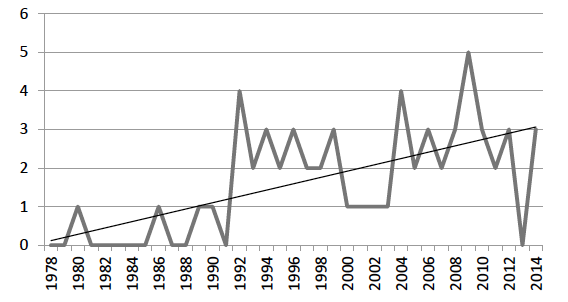
Figure 3.
Biotechnology special interest sessions with trend line.
Special interest sessions with a primary focus on drafting ( n = 18) or computer-aided design or computer-aided drafting (CAD; n = 74) are illustrated in Figure 4. There were a significant number of CAD presentations spanning 1984-1992 during the introduction of personal computers, after which the number of sessions became very sporadic. The spike of eight CAD sessions that occurred in 2000 was mostly comprised of sessions that focused on three-dimensional or parametric modeling. Overall, the number of sessions in this category does not match the level of secondary course offerings in the United States that Sanders (2001) found, showing that drafting or CAD was the second most taught course in his national survey.
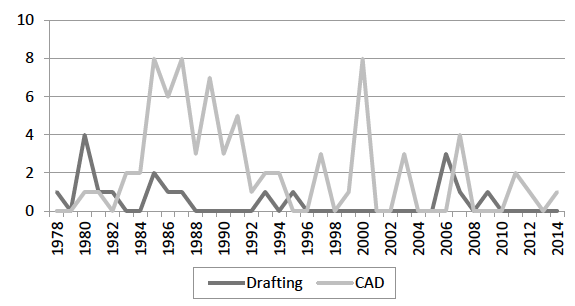
Figure 4.
CAD and drafting special interest sessions with trend lines.
Curriculum content organizers based on the Jackson's Mill Industrial Arts Curriculum Theory ( Snyder & Hales, 1981 ) are presented in Figure 5. All four areas have been sporadically represented throughout the time under study with communication having the most special interest sessions and construction the least. The sporadic nature of these content organizers may be due to other more specific yet related curriculum content organizers. For example, special interest sessions dealing with drafting, CAD, computers, the Internet, and graphic arts may have been counted under those topics and, depending on the primary focus, may not have also fit the communication category if the session focused on technical skill development or an activity as opposed to curriculum.
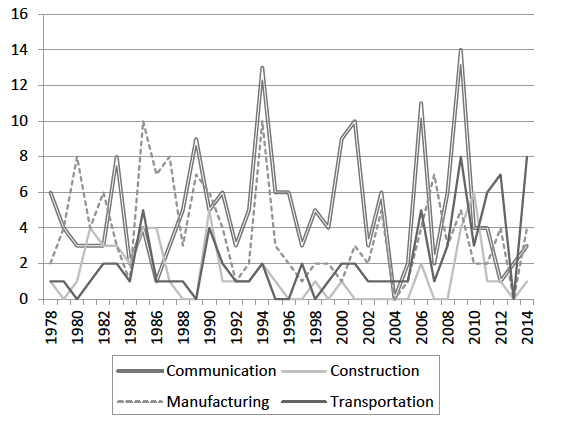
Figure 5.
Communication, construction, manufacturing, and transportation special interest sessions.
The special interest sessions for electricity/electronics and energy and power, plotted in Figure 6, demonstrate several interesting trends. First, energy and power peaked in 1979, declined for over 10 years until 1996, and then averaged about four sessions annually over the last 8 years. Second, electricity/electronics has been sporadically presented, which is surprising given the proliferation of electronic devices over the past 20 years. However, this trend may be due to sessions in related topics (i.e., robotics) that may not have focused primarily on electricity/electronics curriculum. Finally, from 1984-2014, the trend lines for these two topics are very similar, almost mirroring each other at points.
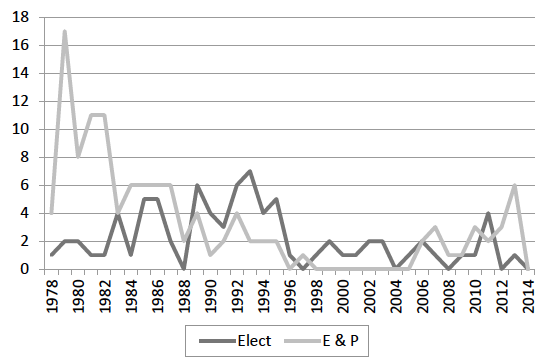
Figure 6. Electricity/electronics and energy and power special interest sessions.
Special interest sessions on engineering have increased significantly since 2000 (see Figure 7) with the number of sessions in 2007, 2011, and 2012 comprising almost one third of all special interest sessions. Early engineering sessions in the 1980s and 1990s frequently reference career and curricular connections to organizations such as the Society of Manufacturing Engineers (SME), Institute of Electrical and Electronics Engineers (IEEE), and the National Aeronautics and Space Administration (NASA). Although these early sessions briefly describe connections to engineering organizations and the term engineering is in the interest session title or description, it is often difficult to discern the depth of these connections. Beginning in 2000, however, the curriculum connections are much clearer because there are specific references to curriculums such as Engineering by Design (EbD), Engineering is Elementary (EiE), and Project Lead the Way (PLTW). Additionally, sessions from the National Center for Engineering and Technology Education (NCETE) as well as engineering sessions connected to key publications such as the Standards for Technological Literacy ( ITEA, 2000 ) and Engineering and Technology Education ( Custer & Erekson, 2008 ) have flourished since 2000. The themes for the 2009 and 2012-2014 conferences may have also influenced the number of engineering sessions because they each denote a focus on engineering (see Table 2). Overall, the number of special interest sessions on engineering is a reflection of broader professional trends leading up to and including the association name change to the ITEEA in 2010.
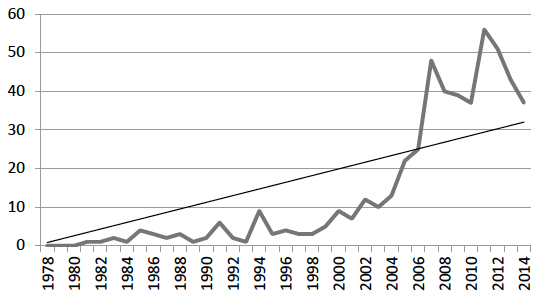
Figure 7.
Engineering special interest sessions with trend line.
"Technology and society" has long been recognized as a key curriculum organizer ( DeVore & Lauda, 1976 ; Anderson & Bensen, 1980 ) and encompasses an entire chapter (four standards, 20%) of the Standards for Technological Literacy ( ITEA, 2000 ). However, Figure 8 illustrates that this topic has been sporadically presented during the period under review, including 11 years in which no technology and society special interest sessions were offered. This topic clearly has not been adequately presented ( n = 63, mean = 1.70) given the amount of literature within the profession (e.g., DeVore & Lauda, 1976 ; Anderson & Bensen, 1980 ; Custer & Wiens, 1996 ; ITEA, 2000 ) as well as documents such as Technically speaking: Why all Americans need to know more about technology ( National Research Council [NRC], 2002 ) from the National Academies and initiatives such as the National Assessment of Educational Progress Technology and Engineering Literacy (NAEP-TEL) assessment ( National Assessment Governing Board, 2014 ).
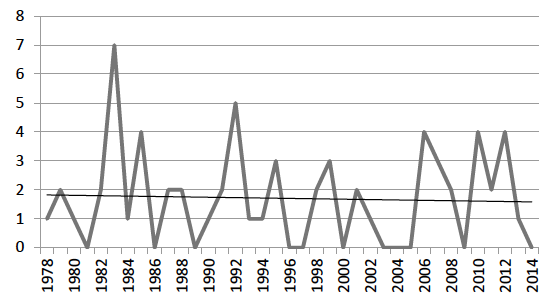
Figure 8.
Technology and society special interest sessions with trend line.
Diversity
Special interest sessions with a primary focus on gender, ethnicity, culture, race, or equity were counted and are presented in Figure 9. General diversity sessions peaked in 1995 ( n = 8), possibly due to the conference theme Technology Education and the Multicultural Society, but have otherwise been very sporadic. There was a higher interest in gender diversity in 1982, 1997, and 2007-2011. The peaks in 1982 and 1997 were initially thought to reflect a connection to the 1982 ACIATE and 1998 CTTE yearbooks ( Maley & Starkweather, 1982 ; Rider, 1998 ), but a search across presenters did not show a correlation with yearbook contributors. The latest peak in special interest sessions focusing on gender (2007-2011) could not be attributed to conference themes or publications but is a positive trend. Finally, there have been 10 total special interest sessions that focus on ethnicity. It is clear that despite the 1993-1995 ITEA strategic goal to "enhance participation of minorities and women in technology" ( Starkweather, 1995, p. 554 ), more attention is needed in all areas associated with diversity.
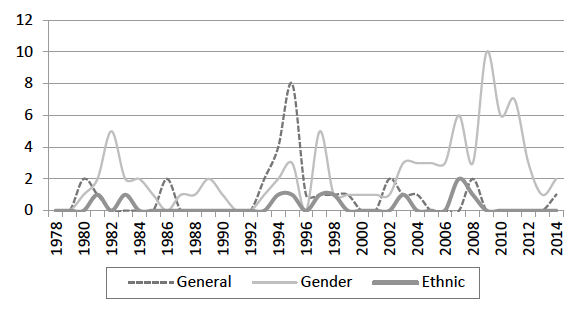
Figure 9.
Diversity special interest sessions.
Individual Topics
Like curriculum topics, there are a number of individual topics for which trend line analysis is not practical because there are so few sessions or the number of sessions drops off completely. Special interest sessions focusing primarily on accreditation totaled just 13 sessions from 1996-2010. Most of these sessions focused on National Council for Accreditation of Teacher Education (NCATE) portfolio preparation or review. This is a very small number considering the importance of accreditation for teacher preparation programs. Financial implications, however, caused the ITEA/CTTE to suspend participation as a NCATE Specialized Professional Association (SPA) in 2010, which probably explains the abrupt end to accreditation special interest sessions.
Interest in alternative energy seems to correspond with energy crises, such as the one that occurred in the late 1970s and early 1980s (see Table 3). There was another small surge in presentations in 1994, perhaps driven by the Gulf War and a renewed awareness of our dependence on other countries for oil. A third peak occurred in 2010, perhaps due to the conference theme Green Technology: STEM Solutions for 21st Century Citizens! The overall number of alternative energy sessions is quite low, and in 14 years, not a single presentation on alternative energy was made. Considering the importance of energy to the global future and further development of technology, there is an insufficient amount of attention in this area.
Special interest sessions were considered to fit under the history category if they focused on the history of the profession and/or technologies. Presentations on history ( n = 68) have been sporadic from year to year with an emphasis on history in the early years of this study. Perhaps this is due to the heavy focus on curricular content and STEM integration since the mid-1990s.
Teacher recruitment is another sparsely represented topic ( n = 66), having just one session across a span of 17 years and 4 years with no sessions. The peak number of teacher recruitment sessions occurred in 1981 and 1995. Four presentations were made in each of these years. Considering that teacher shortage has been a persistent problem in the profession ( Moye, 2009 ; Ndahi & Ritz, 2003 ), there have been very few special interest sessions on recruitment.
Robotics is a topic that has been the primary focus of 94 presentations since 1982, but these sessions have been very sporadic. There was a peak of nine sessions in 1985, and then from 1987-2000, there were few sessions, including 5 years with no sessions. Beginning in 2001, however, there has been a fairly consistent increase in robotics sessions, which corresponds to the recent high visibility of robotics through programs such as FIRST, VEX, and SeaPerch.
Respondents to Sanders (2001) national survey indicated that 22.9% of their students were special needs students, yet only 66 total special interest sessions focused on this area. Special needs interest sessions peaked in 1982 ( n = 12) but quickly dropped to a total of seven for the entire decade of the 1990s. The high initial level was likely due to federal laws that mandated inclusion of special needs students. Overall, when considering the increasing awareness about addressing the needs of special populations, the number of interest sessions devoted to this topic is insufficient.
Special interest sessions that focused on teaching about computers or the Internet are illustrated in Figure 10. The number of interest sessions focusing on computers in technology education increased steadily until 1985, peaking at 21 sessions. Since then, the numbers have steadily decreased. The pioneering session on the Internet occurred in 1994. By 1996, the number peaked at eight interest sessions but has dropped to between 0 and 2 since 2008. It appears that computers and the Internet have become a regular part of our practice.
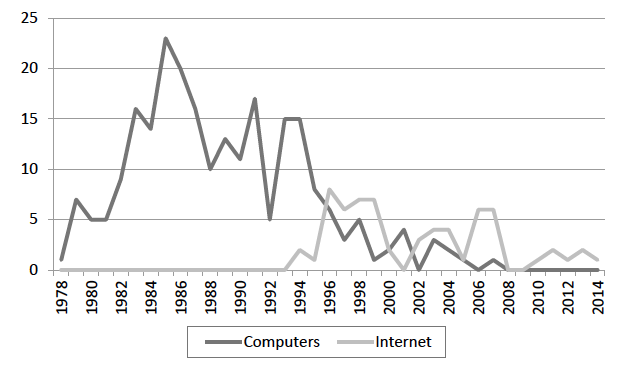
Figure 10.
Computer and Internet special interest sessions.
Warner (2011) provides a compelling literature review documenting the history of design and creativity in technology education. Figure 11 illustrates the trends for creativity and design special interest sessions. Creativity has been fairly consistently represented but accounts for only 97 sessions. Perhaps the conceptual framework for design and creativity offered by Gemmill (2011) will increase the number of interest sessions on creativity in the future. Design, on the other hand, has had a significant number of sessions ( n = 623) that have steadily increased over time. Hopefully, this trend will continue given technology and engineering education's history, pragmatic approach to teaching, and the heavy focus on design in the Standards for Technological Literacy ( ITEA, 2000 ).
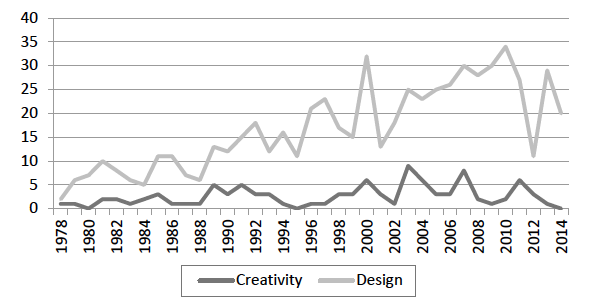
Figure 11.
Creativity and design special interest sessions.
Elementary interest sessions were fairly consistent from 1978-1990, increasing until 1999 then leveling off to approximately 16 sessions per conference (Figure 12). The elementary council, represented as ACESIA, TECC, and CC in Table 3, has consistently provided leadership and has sponsored 259 sessions during the period under study. Additionally, the 1997 CTTE yearbook Elementary School Technology Education ( Kirkwood & Foster, 1997 ) and the continued availability of elementary group membership in ITEEA may have positively influenced the number of elementary special interest sessions.
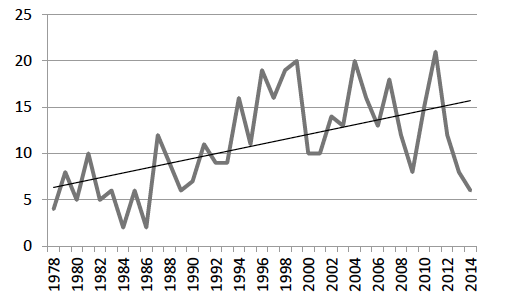
Figure 12.
Elementary special interest sessions with trend line.
Three topics related to learning environments are illustrated in Figure 13: facilities, distance learning, and modular technology education. Facility sessions peaked during the conferences spanning 1989-1994, which may be the result of the four CTTE yearbooks released during that timeframe, each of which included a chapter on facilities ( Liedtke, 1990 ; Wright & Komacek, 1992 ; Seymour & Shackelford, 1993 ; Wescott & Henak, 1994 ). Since that time, however, special interest sessions on facilities have dropped considerably.
Early special interest sessions on distance, online, distributed, and virtual learning focused on resources (i.e., NASA, Innovation Curriculum Online Network [ICON]) and learning communities. Sessions during the peak years of 2001-2008 began to focus more on delivery of undergraduate and graduate programs. Several sessions were delivered by contributing authors of the 54th CTTE yearbook Distance and Distributed Learning Environments ( Havice & Havice, 2005 ).
The primary focus on modular technology education (MTE) occurred within the 1990s. Earlier MTE sessions were primarily related to informing participants on how to produce their own "instructional modules," but more recent sessions focused on commercially developed modular systems. The steady decline of sessions with none occurring since 2006 may indicate that MTE has become an accepted practice or that it is no longer a viable learning environment. More research is needed on this trend.
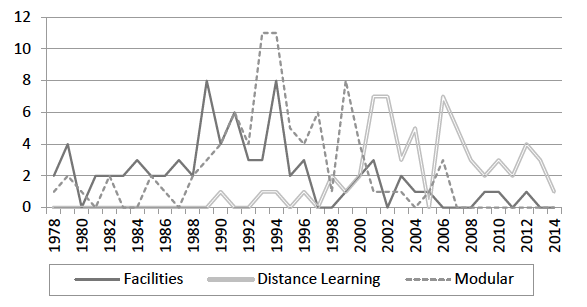
Figure 13.
Facility, distance learning, and modular special interest sessions.
Special interest sessions with a primary focus on funding for facilities, programs, and material development inclusive of fundraising, legislation, and grants are plotted in Figure 14. Notable organizations from these sessions include the National Science Foundation (NSF), the United States Office of Education (USOE in the early years, currently U.S. Department of Education), NASA, and the Technical Foundation of America. Only 34 total sessions dealing with legislation were identified after searching the terms law, legislate, legislation, and lobby while discounting confounding terms (i.e., Ohm's Law). Legislative sessions have primarily addressed special needs students and funding (i.e., Carl D. Perkins). The number of sessions for both funding and legislation is very low considering that technology and engineering education is not a core discipline in the schools, thus making it more susceptible to funding and legislative changes.
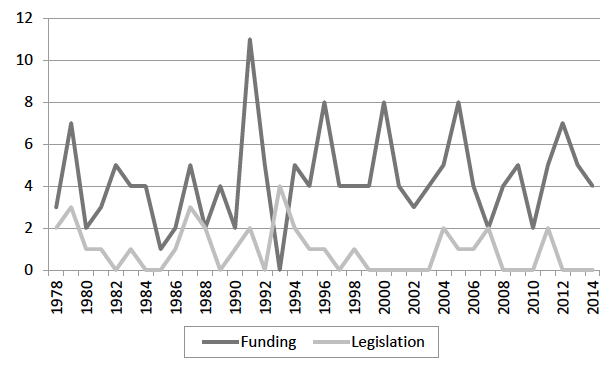
Figure 14.
Funding and legislation special interest sessions.
Three topics related to instructional strategies are illustrated in Figure 15: problem solving, hands-on, and systems. All of these areas have been heavily presented. Sessions on problem solving or problem-based learning were selected if they focused on instruction not on solving problems of the profession (i.e., Wicklein, 1993 ). The increase in problem solving, hands-on, and systems sessions in the late 1980s and early 1990s may have been influenced by the research and experimentation work of Maley (1986) or the focus on technical research ( Israel & Wright, 1987 ). An average of three to four sessions on systems have occurred since that time. At the same time, hands-on sessions have increased and problem-solving sessions have leveled off to approximately five per conference. A note of caution must be made about classifying these three topics. Problem solving and the systems approach have long histories within technology and engineering education (see Martin 1979 ; Martin 1995 ; Schwaller & Kemp, 1988 ; Helgeson & Schwaller, 2003 ), but the term hands-on is a bit more amorphous in the literature. All three terms represent complex instructional strategies, and session presenters are limited in the length of their titles and descriptions (currently seven words for titles and 25 words for descriptions). Sessions were selected for these three categories by the researchers if their primary focus fit the category; however, the depth with which these complex topics were covered in the special interest session is very difficult to discern.
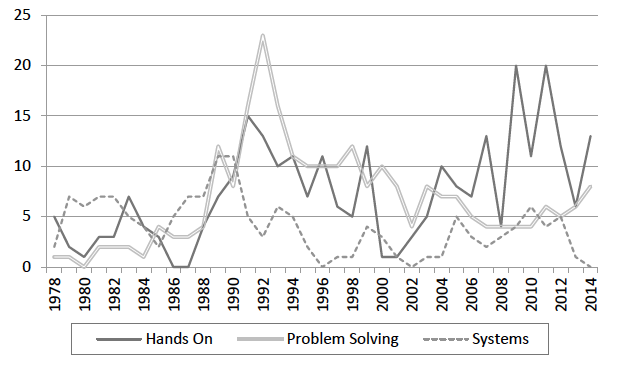
Figure 15.
Hands-on, problem solving, and systems special interest sessions.
Very few international presentations were made until 1988, which is when the Pupil's Attitudes Towards Technology (PATT) conference was first co-located with the ITEA. The PATT conference was not co-located with the ITEEA from 1989-1998, which may explain the downward trend in international sessions during this period. A session was tagged as international if it focused on non-U.S. industrial arts or technology education, and sessions sponsored by PATT did not automatically mean they met this category. The peak in international sessions in 2000 is due in large part to co-locating the PATT-10 conference (Figure 16), and the peak in 2007 is due in large part to co-locating the PATT-17 and the release of the CTETE yearbook International Technology Education ( Williams, 2006 ).
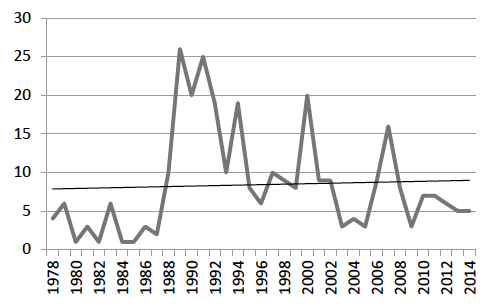
Figure 16.
International special interest sessions with trend line.
Presentations focused on developing leadership or professionalism were rather sporadic until 2004. The increase since 2004 may be attributed to initiatives (i.e., 21st Century Leadership Academy, Administrative Strand in 2014) and STEM integration activities. Leadership may also be gauged by groups that sponsor special interest sessions. These session sponsors are listed in Table 1 by the acronym printed in the conference programs. Additionally, the sponsor's name is listed with information regarding previous and current names to help identify congruency across the conference programs. Lauda (1995) provides a detailed history of council changes as well as their focus within the association.
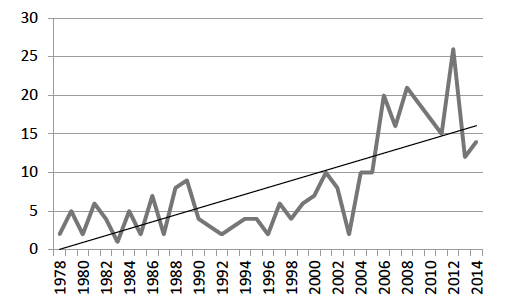
Figure 17.
Leadership special interest sessions with trend line.
Another way to look at leadership is to determine who were regular presenters at the ITEEA conferences. The ITEEA 1978-2014 conference special interest session database was established to include up to eight co-presenters per session. These fields were used to identify the presenters with the greatest number of special interest sessions (Table 4).
Table 4
Greatest number of presentations, by presenter: 1978-2014
| Presenter | Number of Sessions |
|---|---|
| William E. Dugger, Jr. | 73 |
| Mark E. Sanders | 52 |
| John M. Ritz | 36 |
| Michael Hacker | 35 |
| Marc J. de Vries | 30 |
| John G. Wells | 30 |
| Patrick N. Foster | 29 |
| Ray Shackelford | 29 |
| Donald Maley | 27 |
| Charles H. McLaughlin | 27 |
| Patricia Hutchinson | 26 |
| Barry Burke | 26 |
| James Flowers | 25 |
| James E. LaPorte | 25 |
| Gerhard Salinger | 25 |
Presentations on teaching methods have been a recurring theme at the ITEA conferences over the years (Figure 18). This seems in line with what might be expected for a conference sponsored by a professional education association. The surge in the early 2000s may be due to the release of the Standards for Technological Literacy ( ITEA, 2000 ) or an increase in focus on STEM integration.
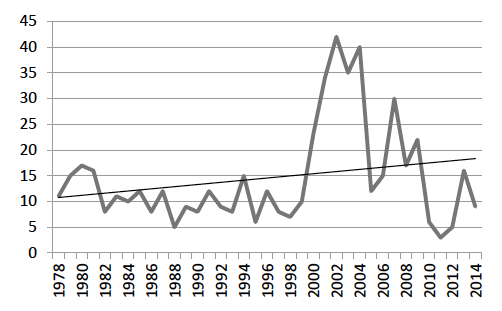
Figure 18.
Teaching methods special interest sessions with trend line.
Overall, interest sessions on scholarly research (Figure 19) have increased since 1978 and reached a peak of 32 in both 2008 and2009. The increases in 1999-2000 are due in large part to the return of the PATT conference sessions. Additionally, we see another increase in 2005-2008 research sessions when the PATT conference themes explicitly focused on research. Additionally, the 2010 CTETE yearbook Research in Technology Education ( Reed & LaPorte, 2010 ) may have impacted the number of research special interest sessions. The consistent increase may be due to a greater amount of funding opportunities to support research. Sessions directly sponsored by NSF or those that mentioned research sponsored by NSF are also plotted in Figure 19 and support the notion of increased funding opportunities.
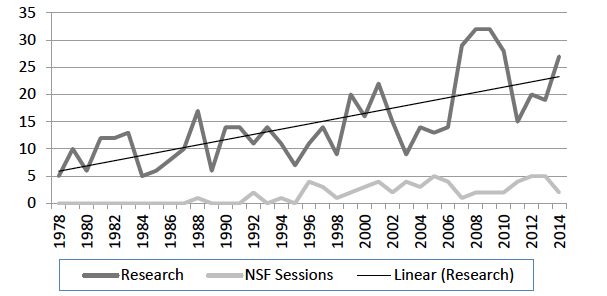
Figure 19.
Research special interest sessions with trend line and NSF special interest sessions.
Despite technology education's inherent focus on technological literacy, the number of sessions prior to the release of the Standards for Technological Literacy ( ITEA, 2000 ) was very small. There is a small spike when the association name changed from the AIAA to the ITEA in 1985. The larger spike in the early 1990s is likely a reflection of the CTTE yearbook Technological Literacy ( Dyrenfurth & Kozak, 1991 ) and the theme of the 1993 conference, Technological Literacy for Life and Work (Table 2). Additionally, publications such as Technically Speaking ( NRC, 2002 ) and Tech Tally ( NRC, 2006 ) have increased the focus on technological literacy in the past 14 years. Sessions relating to these works and a large number of sessions on the ITEEA's Engineering by Design (EbD) curriculum have made technological literacy one of the most consistently offered topics of special interest sessions.
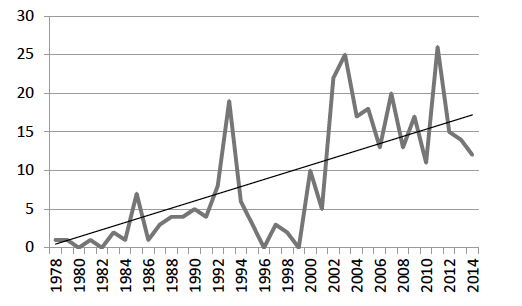
Figure 20.
Technological literacy special interest sessions with trend line.
Special interest sessions were tagged TSM/STEM if the focus of the session was on integrating two or more science, technology, engineering, arts, or mathematics disciplines. The plot and trend line of interest sessions in Figure 21 highlight considerable growth. Early peaks in the 1990s are tied heavily to LaPorte and Sanders's (1993) Technology, Science, Mathematics (T/S/M) Integration Project and Loepp's (1999) Integrated Mathematics, Science, and Technology work at Illinois State University. Since 2007, every conference theme has focused on STEM integration, and the number of interest sessions has increased considerably. This is not surprising given the attention STEM education has received from politicians, corporations such as Exxon/Mobil, and influential organizations such as NSF and the National Academies.
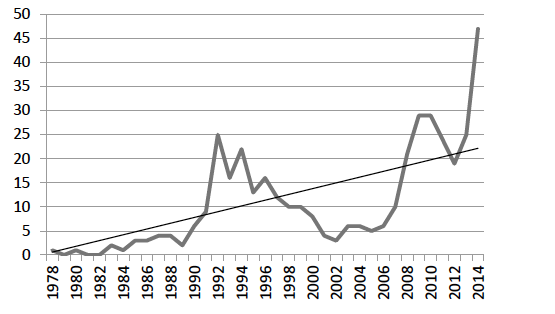
Figure 21.
TSM/STEM/STEAM special interest sessions with trend line.
Summary and Conclusions
This content analysis was designed to highlight historical and apparent emerging trends from 37 annual conferences of the AIAA/ITEA/ITEEA spanning 1978-2014. Thirty-one categories were initially identified, and using a deductive approach, sessions were tagged if the primary focus fit one or more of these categories. An inductive approach was also used to search 17 additional topics using database query tools.
Based on the findings presented above, it appears the following topics have generally been consistently represented at the conferences: communication, creativity, hands-on, international, methods, problem solving, and systems. The focus on these topics over such a prolonged period indicates that conference organizers, presenters, and participants value these topics. The findings of this study also indicate a growing number of presentations on the following topics: biotechnology, curriculum, engineering, gender, design, distance learning, elementary, leadership, research, technological literacy, and STEM integration. These topics represent growth areas for the conference that may be a reflection of what is valued in technology and engineering education or education in general.
The findings of this content analysis also indicate a sporadic number of presentations in certain areas: alternative energy, construction, electricity/electronics, energy and power, history, manufacturing, robotics, technology and society, and transportation. Additionally, certain topics appear to be declining in number: accreditation, CAD, computers, crafts, drafting, facilities, graphic arts, the Internet, metalworking, modular, plastics, production, and woodworking. Inconsistent offering of some sessions or a decline in others related to these topics may be caused by economic factors (i.e., accreditation and alternative energy) or because certain topics have become accepted practice (i.e., construction, the Internet, manufacturing, and transportation). A third possibility is that certain topics may have been subsumed under more contemporary titles, for instance, topics such as metalworking, plastics, and woodworking being included under the topic of materials science. More research into sporadic and declining special interest session topics is needed; however, conclusions are difficult to make from a session title and brief description.
Special interest session presenters are limited to the length of their session title and description (currently seven and 25 words, respectively). Some topics researched in this study fit one or more categories, whereas others did not fit any of the 48 categories. This may be because some topics have clear definitions in the literature (i.e., biotechnology) and others are amorphous (i.e., hands-on). Presenters are encouraged to provide clear titles and descriptions so that conference organizers, attendees, and researchers can better discern the session focus.
Trend line analysis was used in an attempt to establish connections to publications, professional practice, trends, and issues. Some topics were searched because they were recognized in the literature as important to the field but have not been well represented as AIAA/ITEA/ITEEA special interest sessions. These topics include agriculture, ethnicity, general diversity, legislation, medical, recruitment, and special needs. It appears that the ACIATE/CTTE/CTETE yearbook series and the PATT conference series do have some influence on special interest sessions. The conference theme, however, appears to have minimal influence, but the councils and collaborating organizations (i.e., TSA, NASA, NSF, and NAE) have varying degrees of influence resulting from grants, sponsored sessions, publications, and other activities. This analysis highlights the need for the ITEEA to work closely with the conference planning committee, councils, and other session sponsors to identify relevant special interest sessions needed by today's technology and engineering education professionals.
References
Anderson, H. A., & Bensen, M. J. (Eds.). (1980). Technology and society: Interfaces with industrial arts . 29th Yearbook of the American Council on Industrial Arts Teacher Education. Bloomington, IL: McKnight Publishing Company.
Custer, R. L., & Erekson, T. L. (Eds.). (2008). Engineering and technology education . 57th Yearbook of the Council on Technology Teacher Education. Peoria, IL: Glencoe/McGraw-Hill.
Custer, R. L., & Wiens, A. E. (Eds.). (1996). Technology and the quality of life . 45th Yearbook of the Council on Technology Teacher Education. Peoria, IL: Glencoe/McGraw-Hill.
DeVore, P. W., & Lauda, D. P. (1976). Implications for industrial arts. In L. H. Smalley (Ed.), Future Alternatives for Industrial Arts (pp. 137-162). 25th Yearbook of the American Council on Industrial Arts Teacher Education. Bloomington, IL: McKnight Publishing Company.
Dyrenfurth, M. J., & Kozak, M. R. (Eds.). (1991). Technological literacy . 40th Yearbook of the Council on Technology Teacher Education,. Peoria, IL: Glencoe/McGraw-Hill.
Gemmill, P. R. (2011). Conceptual framework and perspectives for creativity and design in technology and engineering education. In S. A. Warner & P. R. Gemmill (Eds.), Creativity and design in technology & engineering education (pp. 321-353). 60th Yearbook of the Council on Technology and Engineering Teacher Education. Reston, VA: Council on Technology and Engineering Teacher Education.
Havice, W. L., & Havice, P. A. (Eds.). (2005). Distance and distributed learning environments: Perspectives and strategies . 54th Yearbook of the Council on Technology Teacher Education. Peoria, IL: Glencoe/McGraw-Hill.
Helgeson, K. R., & Schwaller, A. E. (Eds.). Selecting instructional strategies for technology education 52nd Yearbook of the Council on Technology Teacher Education. Peoria, IL: Glencoe/McGraw-Hill.
International Technology Education Association. (2000). Standards for technological literacy: Content for the study of technology . Reston, VA: Author.
Israel, E. N., & Wright, R. T. (Eds.). (1987). Conducting technical research . 36th Yearbook of the Council on Technology Teacher Education. Peoria, IL: Glencoe/McGraw-Hill.
Julien, H. (2008). Content analysis. In L. M. Given (Ed.), The SAGE encyclopedia of qualitative research methods (Vol. 2; pp. 120-122). Thousand Oaks, CA: SAGE Publications.
Kemp, W. H., & Schwaller, A. E. (Eds.). (1988). Instructional strategies for technology education . 37th Yearbook of the Council on Technology Teacher Education. Peoria, IL: Glencoe/McGraw-Hill.
Kirkwood, J. J., & Foster, P. N. (1997). Elementary school technology education . 46th Yearbook of the Council on Technology Teacher Education. Peoria, IL: Glencoe/McGraw-Hill.
LaPorte, J. E., & Reed, P. A. (2000, April). A content analysis of ITEA conference special interest sessions: 1978-1999, preliminary findings . Paper presented at the 62nd annual Conference of the International Technology Education Association, Salt Lake City, UT.
LaPorte, J. E., & Sanders, M. E. (1993). The T/S/M integration project: Integrating technology, science, and mathematics in the middle school. The Technology Teacher , 52(6), 17-21.
Lauda, D. P. (1995). Professional Councils and Associations. In G. E. Martin (Ed.), Foundations of Technology Education (pp. 567-594). 44th Yearbook of the Council on Technology Teacher Education. Peoria, IL: Glencoe/McGraw-Hill.
Liedtke, J. A. (Ed.). (1990). Communication in technology education . 39th Yearbook of the Council on Technology Teacher Education. Peoria, IL: Glencoe/McGraw-Hill.
Loepp, F. L. (1999). Models of curriculum integration. Journal of Technology Studies , 25(2), 21-25. Retrieved from http://scholar.lib.vt.edu/ejournals/JOTS/Summer-Fall-1999/Loepp.html
Maley, D. (1986). Research and experimentation in technology education . Reston, VA: International Technology Education Association.
Maley, D., & Starkweather, K. N. (Eds.). (1982). The contributions of industrial to selected areas of education . 31st Yearbook of the American Council on Industrial Arts Teacher Education. Bloomington, IL: McKnight Publishing Company.
Martin, G. E. (Ed.). (1979). Industrial arts education: Retrospect, prospect . 28th Yearbook of the American Council on Industrial Arts Teacher Education. Bloomington, IL: McKnight Publishing Company.
Martin, G. E. (Ed.). (1995). Foundations of technology education . 44th Yearbook of the Council on Technology Teacher Education. Peoria, IL: Glencoe/McGraw-Hill.
Moye, J. J. (2009). The supply and demand of technology education teachers in the United States. The Technology Teacher , 69(2), 30-36.
National Assessment Governing Board. (2014). Technology and engineering literacy framework for the 2014 national assessment of educational progress . Washington, DC: Author. Retrieved from http://www.nagb.org/content/nagb/assets/documents/publications/frameworks/technology/2014-technology-framework.pdf
National Research Council. (2002). Technically speaking: Why all Americans need to know more about technology . Washington, DC: National Academies Press.
National Research Council. (2006). Tech tally: Approaches to assessing technological literacy . Washington, DC: National Academies Press.
Ndahi, H. B., & Ritz, J. M. (2003). Technology education teacher demand, 2002-2005. The Technology Teacher , 62(7), 27-31.
Reed, P. A., & LaPorte, J. E. (Eds.). (2010). Research in technology education . 59th Yearbook of the Council on Technology and Engineering Teacher Education. Reston, VA: Council on Technology and Engineering Teacher Education.
Rider, B. L. (Ed.). (1998). Diversity in technology education . 47th Yearbook of the Council on Technology Teacher Education. Peoria, IL: Glencoe/McGraw-Hill.
Sanders, M. E. (2001). New paradigm or old wine? The status of technology education practice in the United States. Journal of Technology Education , 12(2), 35-55. Retrieved from http://scholar.lib.vt.edu/ejournals/JTE/v12n2/pdf/sanders.pdf
Savage, E., & Sterry, L. (Eds.). (1990). A Conceptual framework for technology education . Reston, VA: International Technology Education Association.
Seymour, R. D., & Shackelford, R. L. (Eds.). (1993). Manufacturing in technology education . 42nd Yearbook of the Council on Technology Teacher Education. Peoria, IL: Glencoe/McGraw-Hill.
Silverman, D. (1993). Interpreting qualitative data: Methods for analyzing talk, text, and interaction . Thousand Oaks, CA: Sage Publications.
Snyder, J. F., & Hales, J. A. (1981). Jackson's Mill industrial arts curriculum theory . Charleston, WV: West Virginia Board of Education.
Starkweather, K. N. (1995). The International Technology Education Association. In G. E. Martin (Ed.), Foundations of technology education (pp. 543-566). 44th Yearbook of the Council on Technology Teacher Education. Peoria, IL: Glencoe/McGraw-Hill.
U S. Congress, Office of Technology Assessment. (1988). New developments in biotechnology: U.S. investment in biotechnology (Special Report No. OTA-BA-360). Washington, DC: U.S. Government Printing Office.
Warner, S. A. (2011). Providing the context for creativity and design in technology and engineering education. In S. A. Warner & P. R. Gemmill (Eds.), Creativity and design in technology & engineering education (pp. 1-31). 60th Yearbook of the Council on Technology and Engineering Teacher Education. Reston, VA: Council on Technology and Engineering Teacher Education.
Wells, J. G. (1994). Establishing a taxonometric structure for the study of biotechnology in secondary school technology education. Journal of Technology Education , 6(1), 58-75.
Wescott, J. W., & Henak, R. M. (Eds.). (1994). Construction in technology education . 43rd Yearbook of the Council on Technology Teacher Education. Peoria, IL: Glencoe/McGraw-Hill.
Wicklein, R. C. (1993). Identifying critical issues and problems in technology education using a modified-delphi technique. Journal of Technology Education, 5(1), 54-71. Retrieved from http://scholar.lib.vt.edu/ejournals/JTE/v5n1/wicklein.jte-v5n1.html
Williams, P. J. (Ed.). (2006). International technology teacher education. 55th Yearbook of the Council on Technology Teacher Education. Peoria, IL: Glencoe/McGraw-Hill.
Wright, J. R., & Komacek, S. A. (Eds.). (1992). Transportation in technology education . 41st Yearbook of the Council on Technology Teacher Education. Peoria, IL: Glencoe/McGraw-Hill.